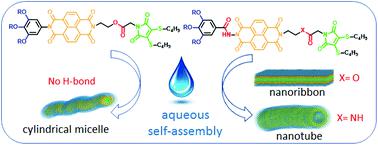Our official English website, www.x-mol.net, welcomes your
feedback! (Note: you will need to create a separate account there.)
Precise control over supramolecular nanostructures via manipulation of H-bonding in π-amphiphiles
Nanoscale ( IF 5.8 ) Pub Date : 2021-11-30 , DOI: 10.1039/d1nr04882a Amrita Sikder 1 , Yujie Xie 1 , Marjolaine Thomas 1 , Matthew J Derry 2 , Rachel K O'Reilly 1
Nanoscale ( IF 5.8 ) Pub Date : 2021-11-30 , DOI: 10.1039/d1nr04882a Amrita Sikder 1 , Yujie Xie 1 , Marjolaine Thomas 1 , Matthew J Derry 2 , Rachel K O'Reilly 1
Affiliation

|
Self-assembled supramolecular architectures are ubiquitous in nature. A synchronized combination of dynamic noncovalent interactions is the major driving force in forming unique structures with high-precision control over the self-assembly of supramolecular materials. Herein, we have achieved programmable nanostructures by introducing single/multiple H-bonding units in a supramolecular building block. A diverse range of nanostructures can be generated in aqueous medium by subtly tuning the structure of π-amphiphiles. 1D-cylindrical micelles, 2D-nanoribbons and hollow nanotubes are produced by systematically varying the number of H-bonding units (0–2) in structurally near identical π-amphiphiles. Spectroscopic measurements revealed the decisive role of H-bonding units for different modes of molecular packing. We have demonstrated that a competitive self-assembled state (a kinetically controlled aggregation state and a thermodynamically controlled aggregation state) can be generated by fine tuning the number of noncovalent forces present in the supramolecular building blocks. The luminescence properties of conjugated dithiomaleimide (DTM) provided insight into the relative hydrophobicity of the core in these nanostructures. In addition, fluorescence turn-off in the presence of thiophenol enabled us to probe the accessibility of the hydrophobic core in these assembled systems toward guest molecules. Therefore the DTM group provides an efficient tool to determine the relative hydrophobicity and accessibility of the core of various nanostructures which is very rarely studied in supramolecular assemblies.
中文翻译:

通过操纵 π-两亲分子中的氢键精确控制超分子纳米结构
自组装超分子结构在自然界中无处不在。动态非共价相互作用的同步组合是形成具有对超分子材料自组装的高精度控制的独特结构的主要驱动力。在此,我们通过在超分子构建块中引入单个/多个 H 键单元实现了可编程纳米结构。通过巧妙地调整 π-两亲物的结构,可以在水性介质中产生多种纳米结构。一维圆柱形胶束、二维纳米带和中空纳米管是通过系统地改变结构上几乎相同的 π 两亲分子中的氢键单元 (0-2) 的数量来产生的。光谱测量揭示了氢键单元对不同分子堆积模式的决定性作用。我们已经证明,通过微调超分子构件中存在的非共价力的数量,可以产生竞争性自组装状态(动力学控制的聚集状态和热力学控制的聚集状态)。共轭二硫代马来酰亚胺 (DTM) 的发光特性提供了对这些纳米结构中核心的相对疏水性的深入了解。此外,在苯硫酚存在下荧光关闭使我们能够探测这些组装系统中疏水核对客体分子的可及性。因此,DTM 组提供了一种有效的工具来确定各种纳米结构的核心的相对疏水性和可及性,这在超分子组装中很少被研究。
更新日期:2021-11-30
中文翻译:

通过操纵 π-两亲分子中的氢键精确控制超分子纳米结构
自组装超分子结构在自然界中无处不在。动态非共价相互作用的同步组合是形成具有对超分子材料自组装的高精度控制的独特结构的主要驱动力。在此,我们通过在超分子构建块中引入单个/多个 H 键单元实现了可编程纳米结构。通过巧妙地调整 π-两亲物的结构,可以在水性介质中产生多种纳米结构。一维圆柱形胶束、二维纳米带和中空纳米管是通过系统地改变结构上几乎相同的 π 两亲分子中的氢键单元 (0-2) 的数量来产生的。光谱测量揭示了氢键单元对不同分子堆积模式的决定性作用。我们已经证明,通过微调超分子构件中存在的非共价力的数量,可以产生竞争性自组装状态(动力学控制的聚集状态和热力学控制的聚集状态)。共轭二硫代马来酰亚胺 (DTM) 的发光特性提供了对这些纳米结构中核心的相对疏水性的深入了解。此外,在苯硫酚存在下荧光关闭使我们能够探测这些组装系统中疏水核对客体分子的可及性。因此,DTM 组提供了一种有效的工具来确定各种纳米结构的核心的相对疏水性和可及性,这在超分子组装中很少被研究。











































 京公网安备 11010802027423号
京公网安备 11010802027423号